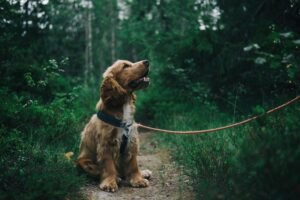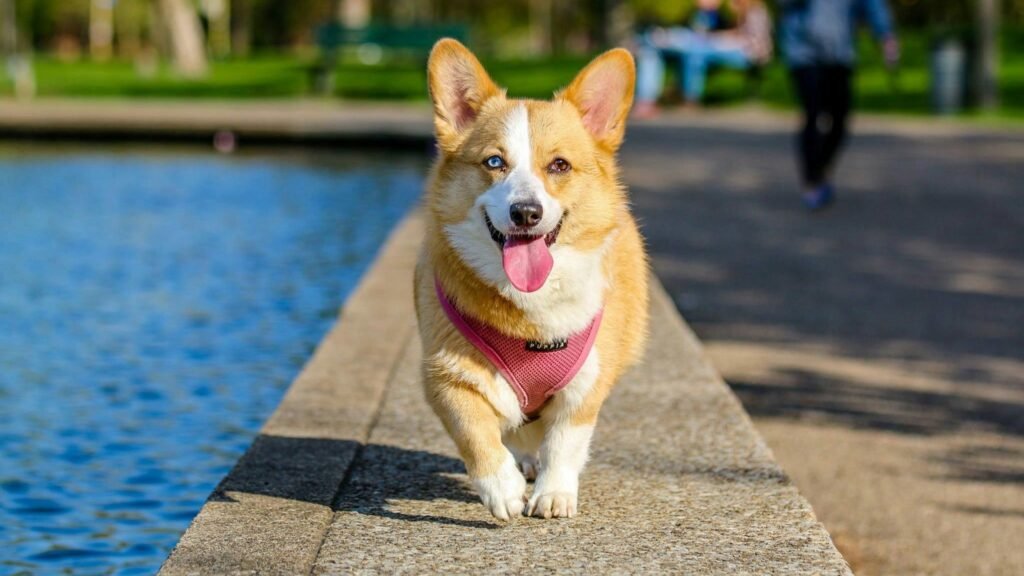Are You Tired of Your Dog’s Leash Biting Ruining Your Walks?
It’s not just annoying – it’s a sign of underlying issues that need attention. In this article, we’ll uncover the surprising reasons behind leash biting and share proven training tips to stop it for good.
By understanding what triggers this behavior, you’ll be able to enjoy peaceful walks with your dog and strengthen your bond. Get ready to transform your walks from frustrating to fantastic – let’s get started!
Why Does My Dog Bite the Leash?
Leash biting in dogs can be attributed to several factors, each shedding light on your pup’s behavior.
1. Boredom
Dogs get bored just like we do. When they don’t have enough to do or think about, they look for ways to use up their extra energy.
Biting the leash becomes a fun game for them. It’s like a toy they always have during walks. This habit gives them something to do when they feel restless or bored.
2. Frustration
Dogs have their desires and curiosities too.
When they’re unable to reach something they’re fixated on, like a scurrying squirrel or a fellow canine friend across the street, frustration can build up.
Biting the leash can be their way of expressing this pent-up frustration, almost like saying, “Let me go chase that!”
3. Attention-Seeking
Dogs are inherently social animals and thrive on human interaction. If your dog feels neglected or simply craves your attention, leash biting can become a way to grab your focus.
It’s their way of saying, “Hey, notice me! Play with me!”
4. Mouthing Instinct
Puppies, in particular, go through a phase of exploration and discovery, and they often use their mouths to interact with the world around them.
Leash biting can be an extension of this instinct, especially in young dogs who are still learning how to interact with their surroundings.
5. Tugging and Playfulness
Some dogs have an innate sense of playfulness, and they view the leash as an invitation to engage in a game of tug-of-war.
The sensation of resistance when they pull on the leash can be exciting and stimulating for them, making it a playful activity.

How to Stop My Dog from Biting the Leash?
Let’s stop your pup’s leash biting before it sticks. Try these proven tips:
1. Tire Them Out with Exercise
Dogs need physical and mental stimulation to stay happy and healthy. When they’re bored or under-exercised, leash biting can become a problem. To prevent this, make sure your furry friend gets plenty of exercise. Take them on long, engaging walks, play active games like fetch or tug-of-war, and introduce interactive toys that challenge their minds.
A tired dog is a happy dog, and they’re less likely to engage in leash biting. By providing adequate physical and mental stimulation, you can reduce the likelihood of this behavior and enjoy more peaceful walks together.
2. Use a Chew Toy
Offer your dog a designated chew toy or bone to redirect their chewing instincts away from the leash.
Choose a toy that is safe, durable, and designed for dogs.
By providing an alternative item for them to chew on, you’ll help satisfy their natural urge to gnaw without damaging the leash.
3. Positive Reinforcement
Positive reinforcement is a powerful tool in training dogs. Whenever your dog refrains from leash biting, be sure to reward them with treats and praise.
This positive feedback helps them associate good behavior with rewards, reinforcing the idea that not biting the leash is the desired action.
4. Obedience Training
Consider enrolling your dog in obedience classes or working on basic commands at home, such as “leave it” or “drop it.”
These commands can be invaluable in controlling leash biting.
When your dog starts to nibble at the leash, you can use these commands to redirect their attention and encourage them to release the leash.
5. Distract and Redirect
When you notice your dog beginning to bite the leash during a walk, remain calm and composed.
Use a command that your dog is familiar with, like “leave it” or “drop it,” to get their attention. Alternatively, have a favorite toy or treat readily available during walks.
When your dog starts biting the leash, offer the toy or treat it as a distraction, then redirect their focus away from the leash.
This redirection technique can be highly effective in curbing leash-biting behavior.
6. Consult a Professional
If your dog’s leash-biting habit persists despite your best efforts, don’t hesitate to seek professional help.
A certified dog trainer or behaviorist can provide specialized guidance and create a tailored training plan to address the specific issues contributing to leash biting.
5 Best Dog Leashes on Amazon
Taglory Dog Leash 6 FT with Comfortable Padded Handle
A premium leash designed for comfort, safety, and durability. Perfect for dog owners who want a reliable walking experience with their furry friends.
Key Features
- Padded handle prevents hand fatigue during long walks
- Reflective threads enhance visibility and safety in low-light conditions
- High-strength nylon material ensures long-lasting performance
Pros
✓ Comfortable grip
✓ Enhanced nighttime visibility
✓ Suitable for medium to large dogs
✓ Affordable pricing
Perfect for:
- Daily walks
- Training sessions
- Active dog owners
- Safety-conscious pet parents
GEIT 4/5/6FT Dog Leash with Double Handles
A tactical-style leash designed for serious dog owners who demand performance, control, and safety during walks and training sessions.
Key Features
- Multiple handles for maximum control and training flexibility
- Reflective threads enhance visibility in low-light conditions
- Durable tactical nylon material built for intense training
Pros
✓ Versatile multi-handle design
✓ Enhanced safety features
✓ Ideal for training and active dogs
✓ Professional-grade construction
Perfect For:
- Professional dog trainers
- Military/police K9 handlers
- Owners of high-energy breeds
TUG 360° Tangle-Free Retractable Dog Leash
A revolutionary retractable leash designed to give your dog exploration freedom while maintaining ultimate owner control and safety.
Key Features
- Patented tangle-free design prevents frustrating leash twists
- One-handed brake and lock system for instant control
- Durable nylon tape with robust internal mechanism
Pros
✓ Smooth, effortless retraction
✓ Instant stop/lock functionality
✓ Suitable for dogs up to 55 pounds
✓ Ergonomic anti-slip handle
Perfect For:
- Active dog owners
- Urban and suburban walking
- Dogs who love exploring
- Owners seeking flexible walking options
Joytale Double-Sided Reflective Dog Leash
Joytale Reflective Dog Leash: Safety Meets Style
A premium leash designed for dog owners who prioritize visibility, comfort, and durability during their walking adventures.
Key Features
- Highly reflective threading for enhanced nighttime safety
- Comfortable padded handle prevents hand fatigue
- Durable nylon material suitable for all dog sizes
Pros
✓ Superior nighttime visibility
✓ Comfortable grip design
✓ Multiple color options
✓ Excellent for evening/early morning walks
Perfect For:
- Safety-conscious dog owners
- Night shift workers
- Urban and suburban walkers
Voyager Reflective Dog Leash with Neoprene Handle
Voyager Dog Leash: Ultimate Comfort and Control
A premium leash engineered for dog owners who demand superior comfort, safety, and training performance in one package.
Key Features
- Soft neoprene handle prevents hand fatigue during long walks
- Reflective threading enhances visibility in low-light conditions
- Supports training and everyday walking needs
Pros
✓ Exceptional comfort design
✓ Enhanced nighttime safety
✓ Versatile for training and walking
✓ Durable construction
Perfect For:
- Active dog owners
- Night walkers
- Owners seeking comfort and control
Dog Leash Biting Training Tips
| Training Tip | Description |
|---|---|
| Provide Adequate Exercise | Ensure your dog gets enough physical and mental stimulation. |
| Offer Chew Toys | Provide safe chew toys to redirect biting instincts. |
| Positive Reinforcement | Reward good behavior with treats and praise. |
| Obedience Training | Enroll your dog in obedience classes for control commands. |
| Distract and Redirect | Divert your dog’s attention away from the leash. |
| Professional Consultation | Seek help from a dog trainer or behaviorist if needed. |
How to Handle Your Dog’s Leash Biting During Walks?
When your dog starts biting the leash during a walk, remember to stay calm and composed. Here’s a simple step-by-step guide:
- Stop Walking: Gently stop walking and stand still. Avoid yanking on the leash, as this can encourage more biting.
- Use a Command: If your dog knows commands like “leave it” or “drop it,” use them to redirect their attention.
- Offer a Toy or Treat: Carry a toy or treat with you on walks. When your dog bites the leash, offer the toy or treat it as a distraction.
- Resume Walking: Once your dog has stopped biting the leash and redirected their focus, continue your walk.
Conclusion
Now you know why your dog bites the leash, it’s time to take action.
Remember, your pup isn’t trying to be naughty – they’re just expressing themselves in the only way they know how. By addressing the real reason behind the biting, you’re not just fixing a problem, you’re building a stronger bond with your furry friend.
Stick to your chosen training method and celebrate every small win. Soon, you’ll be enjoying peaceful walks together. Keep treats handy, stay patient, and watch as leash biting becomes a thing of the past.
FAQs
What to Do If Your Dog Bites the Leash?
If your dog starts biting the leash during a walk, stay calm and avoid yanking the leash. Instead, stop walking, use a command like “leave it” or offer a toy or treat to distract them.
When they release the leash, resume walking. Consistency is key to teaching them that leash biting is not acceptable behavior.
What Does It Mean When a Dog Bites the Leash?
When a dog bites the leash, it can mean various things.
They might be bored and looking for entertainment, frustrated because they can’t reach something they want, seeking attention from you, or simply playing around.
Understanding the underlying reason behind leash biting is crucial to addressing it effectively.
Why Do Dogs Bite the Leash and Walk?
Dogs may bite the leash during walks for several reasons. It could be due to boredom, frustration, attention-seeking, playfulness, or even a natural instinct to explore their surroundings.
Identifying the specific cause behind your dog’s behavior can help you choose the right approach to stop it.
How Do I Stop My Dog from Pulling on the Leash?
To prevent your dog from pulling on the leash, you can start by teaching them leash manners. Use positive reinforcement to reward them when they walk without pulling.
Consider using a no-pull harness or training collar for added control. Consistent training and patience are essential for achieving loose-leash walking behavior.
